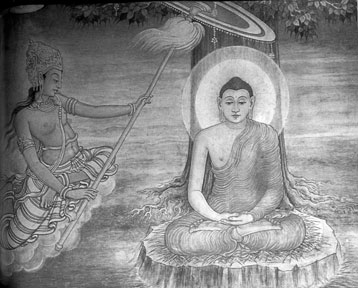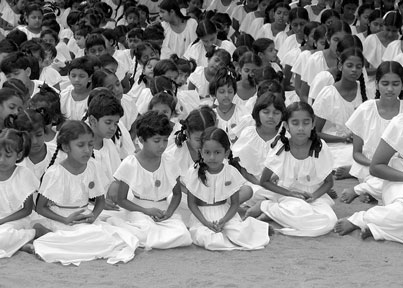|
Sambuddhathwa Jayanthi:
The Triple Gem, one’s refuge
by J.F. Ranjith PERERA
The Vesak Full Moon day which falls on May 17, 2011 is a day of
historic significance to Buddhists around the world. It records 2,600
years since Gauthama Buddha attained Enlightenment. The next
Sambuddhathwa Jayanthi will fall in 3011, one-hundred years later, when
all, young and old living at present, will be dead. Hence, the
Sambuddhathwa Jayanthi which falls on May 17, 2011 will be an extremely
rare occurrence for Buddhists the world over to celebrate.
 What would be the ideal way, particularly for Buddhists, to celebrate
this event of rare religious significance? What would be the ideal way, particularly for Buddhists, to celebrate
this event of rare religious significance?
In the first instance, it is necessary to identify why it has become
necessary for Buddhists to celebrate this event through observance.
The obvious reason is that the majority of the people who are
supposed to profess the preachings of the Buddha do not adhere even to
the Five Precepts, which is a basic discipline expected to be practised
by the Buddhist.
Hence, it has become necessary to persuade them to comply at least
with the practice of following the Five Precepts in their day-to-day
life. This would enable them to celebrate this event with a conscience
that they have practised the religion to the best of their abilities.
Once, when the Buddha was preaching at Jetawanarama, a Brahmin who
was highly respected at the time, for his knowledge and versatility,
known as Janussoni, met Him and inquired from Him why the people do not
practise what He preaches despite the clarity and simplicity of sermons
delivered by Him.
The Buddha explained that this was due to the defilement of Raga,
Dvesha and Moha those people have indulged in throughout Sansara.
Consequently, their power of retention is limited. Hence, they are
unable to remember what they should practise and how they should
practise it.
Sublime
There are some who think that Buddhism is so lofty and sublime that
it cannot be practised by ordinary men and women in this world of ours
and that one has to retire from it to a secluded place, if one desires
to be a practising Buddhist.
This is a misconception due to a lack of understanding of the
teachings of the Buddha. People are led to such hasty and wrong
conclusions due to hearing or reading casually something about Buddhism
without understanding the subject in all its aspects, and gives only a
partial and lopsided view of it.
The Buddha’s teachings are meant not only for bhikkhus, but also for
ordinary men and women living a lay life.
The Noble Eight-Fold Path which is the Buddhist way of life, is meant
for all, without distinction of any kind. If you understand the spirit
of Buddhism you can follow and practise it while living the life of an
ordinary man.
There may be some who find it easier and more convenient to accept
Buddhism, if they live in a remote place, away from others. Others may
find that kind of retirement dulls and depresses their whole being
physically and mentally, and may not, therefore, be conducive to the
development of their spiritual and intellectual life.
It is a misconception to believe that to follow the Buddha’s
teachings one has to retire from lay life.
There are numerous references in Buddhist literature to men and women
living normal family lives who successfully practised what the Buddha
taught and realised - Nirvana.
It may be agreeable for certain people to live a retired life in a
quiet place, away from noise and disturbance. But it is certainly more
praiseworthy and courageous to practise Buddhism, living among your
fellow beings, helping them and being of service to them.
It may perhaps be useful in some cases for a man to live in
retirement for a time to improve his mind and character, to be strong
enough to come out later and help others.
But if a man lives all his life in solitude, thinking only of his
happiness and ‘salvation’ without caring for his fellow beings, it will
not be in keeping with the Buddha’s teachings which is based on love,
compassion and service to others.
Respect
The Sigalovada Sutta shows with what great respect the layman’s life,
his family and social relations were regarded by the Buddha.
Sigala was a young man who worshipped the six cardinal points of the
heavens - East, South, West, North, Nadir and Zenith - in obeying and
observing the last piece of advice given to him by his dying father.
The Buddha preached to the young man that in the “noble discipline”,
the six directions were: East - parents; South - teachers; West - wife
and children; North - friends, relatives and neighbours; Nadir -
servants, workers and employees; Zenith - religious men.
The Buddha preached to Sigala that one should worship these six
directions. By “worship” the Buddha meant worshipping something sacred,
worthy of honour and respect. These six family and social groups are
treated in Buddhism as sacred. But how is one to worship them? The
Buddha preached that one could worship them only by performing one’s
duties towards them. These duties were explained by the Buddha in his
discourse to Sigala.
First - Parents are sacred to their children
The Buddha preached that parents are called Brahma.
The term ‘Brahma’ denotes the highest and the most sacred conception
in Indian religious thought, and in it the Buddha included the parents.
So in good Buddhist families the children literally worship their
parents every morning and evening. They have to perform certain duties
towards their parents according to the ‘noble discipline’.
They should look after their parents in their old age; should do
whatever they have to do on their behalf; should maintain the honour of
the family and continue the family traditions; should protect the wealth
earned by their parents; and perform their funeral rites after their
death.
Parents in turn have certain responsibilities towards their children.
They should keep their children away from evil courses: should engage
them in good and profitable activities; should give them a good
education; should marry them into good families; and should hand over
the property to them in due course.
Obedient
Second: The relation between the teacher and pupil
A pupil should respect and be obedient to his teacher; should attend
to his needs if any; and should study earnestly.
The teacher in his turn should train and shape his pupil properly;
should teach him well; should introduce him to his friends; and try to
procure him security or employment when his education is over.
Third: The relation between husband and wife
Love between husband and wife is considered almost religious or
sacred. It is called ‘sacred family life’ (Sadara Brahmacariya). Here
too the significance of the term ‘Brahma’ should be noted: the highest
respect is given to this relationship.
Wives and husbands should be faithful, respected and devoted to each
other, they have certain duties towards each other: the husband should
always honour his wife and never be wanting in respect to her; should
secure her position and comfort and should please her by presenting her
with clothing and jewellery.
 The wife in turn should supervise and look after household affairs,
should entertain guests, visitors, friends and relatives and employees;
should love and be faithful to her husband; should protect his earnings;
should be clever and energetic in all activities. The wife in turn should supervise and look after household affairs,
should entertain guests, visitors, friends and relatives and employees;
should love and be faithful to her husband; should protect his earnings;
should be clever and energetic in all activities.
Fourth: The relation between friends, relatives and neighbours
They should be hospitable and charitable to one another; should speak
pleasantly and agreeably; should work for each other’s welfare; should
be on equal terms with one another; should not quarrel among themselves,
should help each other in times of need; and should not forsake each
other in times of difficulty.
Obligations
Fifth: The relationship between master and servant
The master or the employer has several obligations towards his
servant or his employee; work should be assigned according to ability
and capacity: adequate wages should be paid; medical needs should be
provided; occasional donations or bonuses should be granted.
The servant or employee, in turn, should be diligent and not lazy;
honest and obedient; not cheat his master; he should be earnest in his
work.
Sixth: The relation between the religious and the laity
Lay people should look after the material needs of the religious
people with love and respect.
The religious with a loving heart should impart knowledge and
learning to the laity; and lead them along the good path, away from
evil.
Hence it is clear that lay life, with its family and social
relations, is included in the ‘noble discipline’, and is within the
framework of the Buddhist way of life, as the Buddha envisaged it.
If one desires to become a Buddhist, there is no invitation ceremony
which one has to undergo. If one understands the Buddha’s teachings and
if one is convinced that His teachings are the right path and if one
tries to follow them, then one is a Buddhist.
But according to unbroken age-old tradition, one is considered a
Buddhist if one considers the Buddha, the Dhamma and the Sangha -
generally called ‘the Triple Gem’ - as one’s refuge and undertakes to
observe the Five Precepts (Panchaseela) the minimum moral obligations of
a lay Buddhist (1) not to destroy life (2) not to steal (3) not to
commit adultery (4) not to tell lies (5) not to take intoxicating drinks
or drugs.
Hence it is clear that the most appropriate way for a Buddhist to
celebrate the Sambuddhathwa Jayanthi is to take the ‘Triple Gem’ as
one’s refuge and observe the Five Precepts, the minimum moral
obligations of a lay Buddhist.
|

